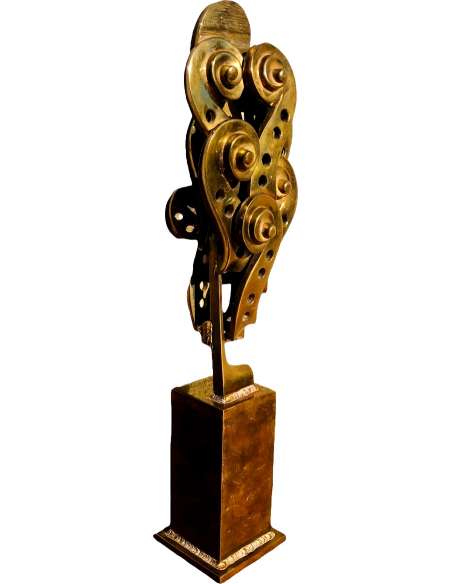"arman Bronze Sculpture Signed 20th Century Violin Crosses Modern Art"
ARMAN ( 1928 / 2005 )
Accumulation of violin sticks.
Welded bronze sculpture, golden patina, signed on the base, cast iron Bocquel, numbered 22/50 on the back on the base.
Height: 41 cm
Width: 12.5 cm
Depth: 8.5 cm
Sculpture referenced under number 43 in the catalogue raisonné of the multiples.
ARMAN, born Armand Fernandez on November 17, 1928 in Nice and died in New York on October 22, 2005, is a Franco-American artist, painter, sculptor and visual artist, renowned for his "accumulations". He was one of the first to directly use, as pictorial material, manufactured objects, which for him represented the multiple and infinite extensions of the human hand that undergo a continuous cycle of production, consumption, destruction.The only son of Antonio Fernandez, a furniture and antiques dealer, of Spanish origin who lived in Algeria, and Marguerite Jacquet, from a family of farmers from the Loire, the young Armand shows very early disposition for drawing and painting. After his bachelor's degree, he studied at the School of Decorative Arts in Nice (today the villa Arson), then at the Louvre school. He met Yves Klein and Claude Pascal at the judo school they attended in Nice in 1947. With these two friends, he became interested for a while in oriental philosophies and Rosicrucian theory.At the end of 1957, Arman, who signs his works with his first name in tribute to Van Gogh, decides to abandon Armand's "d" and formalizes his signature as an artist, in 1958, on the occasion of an exhibition at Iris Clert.In October 1960, he made the exhibition "Le Plein" where he filled Iris Clert's gallery with discarded objects and the contents of selected trash cans. This exhibition is the counterpoint to the exhibition "The Void" organized two years earlier at the same gallery by his friend Yves Klein.Also in the same month, under the leadership of the art critic Pierre Restany, Arman becomes, with Yves Klein, one of the founding members of the group of New Realists (proclaimed by Restany: "new perceptive approaches to reality"), alongside François Dufrêne, Raymond Hains, Martial Raysse, Daniel Spoerri, Jean Tinguely and Jacques Villeglé, joined later by César, Mimmo Rotella, Niki de Saint Phalle, Gerard Deschamps and in 1963 Christo.From 1961, Arman develops his career in New York, where he resides and works half of his time, alternating with his life in Nice until 1967, then in Vence until his death. In New York, he stayed first at the Chelsea Hotel until 1970, then in a loft in the SoHo district and, from 1985, in his building in TriBeCa, where he died in 2005.After his death in New York, some of his ashes were brought back to Paris in 2008 to be buried at the Père Lachaise Cimetiere1.All his life, Arman was also a passionate collector of everyday objects (watches, weapons, pens ...) and art objects, in particular traditional African art of which he was a connoisseur, appreciated and recognized specialist.Arman had dual citizenship, French and American, acquired in 1972.The workeArman was interested in the status of the object and the relationship that modern societies maintain with it, between sacralization and overconsumption-destruction.In 1955, the Haut-Pavé Gallery organized its first solo exhibition in Paris.His first "Cachets" (traces of inked or painted objects) in Paris date from 1956.In 1959, he begins the realization of the series of "Garbage Cans": he exhibits household garbage, detritus found in the street and waste. His "accumulations" of objects following a quantitative logic that erases their singularity send back an image of profusion, at the same time that they underline the perishable character of the products of the society of abundance.In 1960, he uses plexiglas for the first time.In 1961, he began the series of "Angères": destruction of objects (the "Cuts" of violin, piano, double bass ...) expertly glued on pedestals or on wall supports. In the "Combustions" (1963), these same objects are burned.Between 1980 and 1999, the range of works and techniques expanded. Arman declines and multiplies the various execution procedures. At the end of the 1990s, the work became radicalized into a succession of gestures related to the object (Accumulations in Relation, Cascades, Combo Sandwiches). He shows a renewed interest in painting (The Starry Night, Nec Mergitur).A major retrospective takes place at the National Gallery of the Jeu de Paume from January to April 1998, an exhibition that brings together more than a hundred works (from 1959 to 1997). The retrospective then travels until 2001 to Germany, Portugal, Israel, Brazil, Mexico, Taiwan, Spain ... In 2000, he works on fragmentations on panel, fragments (drawings and sculptures). He presents a thematic retrospective ("The Crossing of Objects"), at the Château de Villeneuve, in Vence (France).His bronze sculptures participate in a similar gesture: the artist seizes the icons of Western art (Venus de Milo, Hercules Farnese, etc.), which he cuts off to then sew them back together in a searched mess.In 2002-2003, Arman returned to easel painting in a series of works, "Serious Paintings", which combine the recomposition of musical instruments with their "staging" in painting.
violondingres.f
Description
Reviews
No reviews
Arman, violin sticks
modern art style. 20th century
Vendu
9800 €












Period:
XX th c.
Style:
Modern Art
Material:
Tan
Signatures:
Arman
Origin:
France
- Widht :
- 12,5 cm (4,88 In)
- Height :
- 41 cm (15,99 In)
- Depth :
- 8,5 cm (3,32 In)
890 people viewed this item

 English
English  Français
Français











